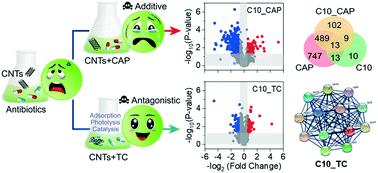当前位置:
X-MOL 学术
›
Environ. Sci.: Nano
›
论文详情
Our official English website, www.x-mol.net, welcomes your feedback! (Note: you will need to create a separate account there.)
Carbon nanotubes influence the toxic effects of chloramphenicol and tetracycline on cyanobacterium Synechocystis sp. in different ways
Environmental Science: Nano ( IF 7.3 ) Pub Date : 2021-2-15 , DOI: 10.1039/d0en01204a Mingtao You 1, 2, 3, 4, 5 , Xiuqi You 1, 2, 3, 4, 5 , Jingrun Hu 1, 2, 3, 4, 5 , Xi Yang 6, 7, 8, 9 , Weiling Sun 1, 2, 3, 4, 5
Environmental Science: Nano ( IF 7.3 ) Pub Date : 2021-2-15 , DOI: 10.1039/d0en01204a Mingtao You 1, 2, 3, 4, 5 , Xiuqi You 1, 2, 3, 4, 5 , Jingrun Hu 1, 2, 3, 4, 5 , Xi Yang 6, 7, 8, 9 , Weiling Sun 1, 2, 3, 4, 5
Affiliation

|
Despite many studies on the toxicity of nanomaterials or antibiotics to aquatic organisms, the combined toxicity of nanomaterials and antibiotics remains poorly understood. This study investigated the joint toxicity of carbon nanotubes (CNTs) with chloramphenicol (CAP) or tetracycline (TC) to cyanobacterium Synechocystis sp. strain PCC 6803. Both reactive oxygen species (ROS) quenching experiments and proteomic analysis demonstrated that the oxidative stress caused by ROS contributed to the toxicity of CNTs but was irrelevant to the toxicity of CAP and TC despite the increased ROS levels in their exposure groups. CNTs upregulated photosynthesis significantly in response to its oxidative stress and shading effects. CAP vastly inhibited protein biosynthesis and resulted in the small size of cells. TC significantly downregulated the proteins related to periplasmic space which is responsible for cell wall biosynthesis, thereby inducing severe destruction of the cell wall. CNTs mitigated the inhibition effect of CAP on protein biosynthesis, while CAP enhanced the upregulation of proteins induced by CNTs. Consequently, an additive effect was observed between CNTs and CAP according to mortality. In contrast, CNTs exhibited an antagonistic effect with TC due to the strong adsorption and catalytic degradation of TC by CNTs. Moreover, TC can potentiate the CNT-induced downregulation of proteins related to ribosome. This study provides a more realistic insight into the molecular mechanisms of pollutant toxicity and highlights the importance of considering the different combined toxicity of multiple pollutants in the aquatic environment.
中文翻译:

碳纳米管影响氯霉素和四环素对蓝藻蓝藻的毒性作用。以不同的方式
尽管对纳米材料或抗生素对水生生物的毒性进行了许多研究,但对纳米材料和抗生素的组合毒性仍然知之甚少。本研究调查碳纳米管(CNT)的联合毒性氯霉素(CAP)或四环素(TC)至蓝细菌集胞藻sp。活性氧物种(ROS)淬灭实验和蛋白质组学分析均表明,由ROS引起的氧化应激有助于CNTs的毒性,但与CAP和TC的毒性无关,尽管其暴露组中的ROS含量增加。碳纳米管响应其氧化应激和遮光作用而显着上调光合作用。CAP极大地抑制了蛋白质的生物合成,并导致细胞较小。TC显着下调了与周质空间有关的蛋白质,周质空间负责细胞壁的生物合成,从而引起细胞壁的严重破坏。碳纳米管减轻了CAP对蛋白质生物合成的抑制作用,而CAP增强了碳纳米管诱导的蛋白质的上调。所以,根据死亡率观察到CNT和CAP之间有累加作用。相反,由于CNT对TC的强吸附和催化降解,因此CNT显示出对TC的拮抗作用。此外,TC可以增强CNT诱导的与核糖体相关蛋白的下调。这项研究为污染物毒性的分子机制提供了更现实的见解,并强调了考虑水生环境中多种污染物的不同组合毒性的重要性。
更新日期:2021-03-02
中文翻译:

碳纳米管影响氯霉素和四环素对蓝藻蓝藻的毒性作用。以不同的方式
尽管对纳米材料或抗生素对水生生物的毒性进行了许多研究,但对纳米材料和抗生素的组合毒性仍然知之甚少。本研究调查碳纳米管(CNT)的联合毒性氯霉素(CAP)或四环素(TC)至蓝细菌集胞藻sp。活性氧物种(ROS)淬灭实验和蛋白质组学分析均表明,由ROS引起的氧化应激有助于CNTs的毒性,但与CAP和TC的毒性无关,尽管其暴露组中的ROS含量增加。碳纳米管响应其氧化应激和遮光作用而显着上调光合作用。CAP极大地抑制了蛋白质的生物合成,并导致细胞较小。TC显着下调了与周质空间有关的蛋白质,周质空间负责细胞壁的生物合成,从而引起细胞壁的严重破坏。碳纳米管减轻了CAP对蛋白质生物合成的抑制作用,而CAP增强了碳纳米管诱导的蛋白质的上调。所以,根据死亡率观察到CNT和CAP之间有累加作用。相反,由于CNT对TC的强吸附和催化降解,因此CNT显示出对TC的拮抗作用。此外,TC可以增强CNT诱导的与核糖体相关蛋白的下调。这项研究为污染物毒性的分子机制提供了更现实的见解,并强调了考虑水生环境中多种污染物的不同组合毒性的重要性。



























 京公网安备 11010802027423号
京公网安备 11010802027423号